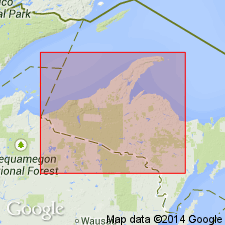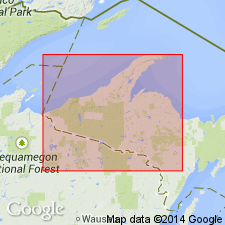
- Usage in publication:
-
- Fern Creek formation*
- Modifications:
-
- Revised
- AAPG geologic province:
-
- Lake Superior region
Summary:
Pg. 35. Fern Creek formation. Revised to basal formation of Chocolay group (new) of Animikie series. Unconformably overlies pre-Animikie crystalline rocks and locally underlies Sturgeon quartzite. Age is middle Precambrian (Animikie Series). Report includes stratigraphic sequence chart.
Source: Publication; US geologic names lexicon (USGS Bull. 1200, p. 1339).

- Usage in publication:
-
- Fern Creek Formation*
- Modifications:
-
- Overview
- AAPG geologic province:
-
- Lake Superior region
Summary:
Pg. 2845 (fig. 2, stratigraphic chart compiled from Leith and others, 1935; James, 1958; Gair and Thaden, 1968). Fern Creek Formation of Chocolay Group of Marquette Range Supergroup (new; replaces †Animikie series of James, 1958, south of Lake Superior, in Michigan and Wisconsin). Present in Menominee Range, northwestern Michigan. Underlies Sturgeon Quartzite of Chocolay Group; unconformably overlies lower Precambrian gneiss. Age is middle Precambrian.
Source: Publication.
For more information, please contact Nancy Stamm, Geologic Names Committee Secretary.
Asterisk (*) indicates published by U.S. Geological Survey authors.
"No current usage" (†) implies that a name has been abandoned or has fallen into disuse. Former usage and, if known, replacement name given in parentheses ( ).
Slash (/) indicates name conflicts with nomenclatural guidelines (CSN, 1933; ACSN, 1961, 1970; NACSN, 1983, 2005, 2021). May be explained within brackets ([ ]).

